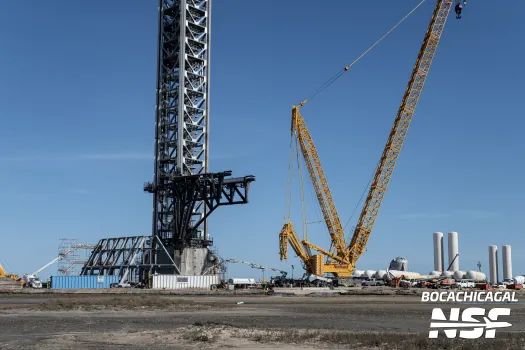
SpaceX Makes Major Strides on Next-Gen Launch Facilities – A Look into the Future of Space Exploration
2025-03-28
Author: Wei
Orbital Launch Pad B: A Step Towards Advanced Spaceflight
In recent weeks, SpaceX has made remarkable advancements on Orbital Launch Pad B, which aims to enhance its launch capabilities. On March 17 and 27, construction crews completed critical concrete pours for the flame trench – a feature vital for safely venting exhaust during launches. Approximately 300 concrete trucks contributed to laying the foundation for this high-tech launch pad, which will support not only future Starship launches but also the ever-evolving rocket technology.
One of the key innovations for Pad B involves the installation of robust steel walls for the flame trench, designed to withstand the immense forces generated during launches. These walls will be filled with additional concrete and work in conjunction with the Orbital Launch Mount, supporting the weight of the Starship rockets.
SpaceX is also in the final stages of making the automated "chopsticks" operational – a crucial component for catching and stabilizing rockets post-launch. While initial movement tests have succeeded, future milestones include load testing with water bags and the installation of stabilizing arms, which would further centralize the system and enhance reliability.
Liquid Oxygen System Innovation
In an exciting development, SpaceX recently tested a new Liquid Oxygen (LOX) pump as part of an advanced exhaust system for Pad B's tank farm. This state-of-the-art facility will implement nine LOX pumps alongside several Liquid Methane (LCH4) pumps, offering flexibility and scaling potential for future missions. The innovative “grass vent” system, initially rolled out on Pad A, will be redesigned for Pad B, featuring enhancements that work in conjunction with powerful ventilation fans to safely disperse gases, akin to the steam from a locomotive.
Moreover, this integrated setup will create a separate vent line for LCH4 systems, further streamlining the fueling process and taking safety measures to the next level.
Transforming High Bay into Gigabay
As progress on Pad B accelerates, the end of an era begins with the dismantling of the High Bay. Constructed in late 2020, the High Bay was pivotal in assembling several key rockets, including the historic Ship 24 and Booster 7. A specialized crew equipped with an LTM 11200 crane has commenced the systematic demolition of High Bay to make way for Gigabay – a facility poised to revolutionize Starship construction.
The new Gigabay is expected to feature 24 advanced workstations and turntables designed for both construction and servicing of spacecraft, which will significantly bolster SpaceX’s production capacity. With the design aiming to streamline operations and integrate more closely with the existing Starfactory and parking garage facilities, this ambitious project is set to redefine how spacecraft are built and maintained.
According to sources within SpaceX, the new Gigabay will house 400-ton bridge cranes, surpassing the lifting capacities of those found in the historic Vehicle Assembly Building at Kennedy Space Center. As plans stand, the complete transformation of the High Bay into Gigabay will likely take around 18-24 months, ushering in a brand-new era of space exploration.
Conclusion: The Future is Bright with SpaceX
With these developments at Hand, SpaceX is not just building facilities but laying the groundwork for the future of humanity's ventures into space. As the company ramps up its efforts to enhance its operational capabilities, the countdown to more innovative missions continues. Keep an eye on Boca Chica – it’s where the next chapter of space exploration is unfolding!




 Brasil (PT)
Brasil (PT)
 Canada (EN)
Canada (EN)
 Chile (ES)
Chile (ES)
 Česko (CS)
Česko (CS)
 대한민국 (KO)
대한민국 (KO)
 España (ES)
España (ES)
 France (FR)
France (FR)
 Hong Kong (EN)
Hong Kong (EN)
 Italia (IT)
Italia (IT)
 日本 (JA)
日本 (JA)
 Magyarország (HU)
Magyarország (HU)
 Norge (NO)
Norge (NO)
 Polska (PL)
Polska (PL)
 Schweiz (DE)
Schweiz (DE)
 Singapore (EN)
Singapore (EN)
 Sverige (SV)
Sverige (SV)
 Suomi (FI)
Suomi (FI)
 Türkiye (TR)
Türkiye (TR)
 الإمارات العربية المتحدة (AR)
الإمارات العربية المتحدة (AR)